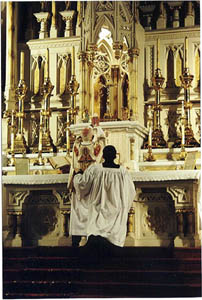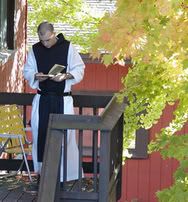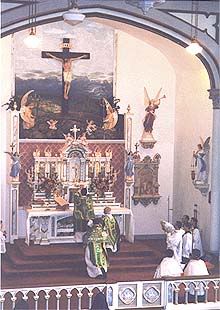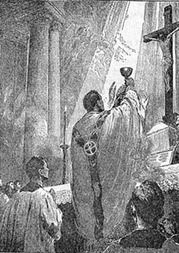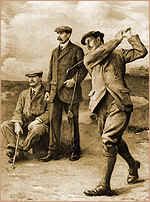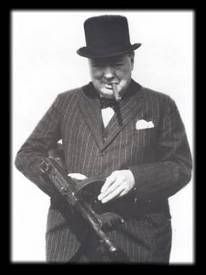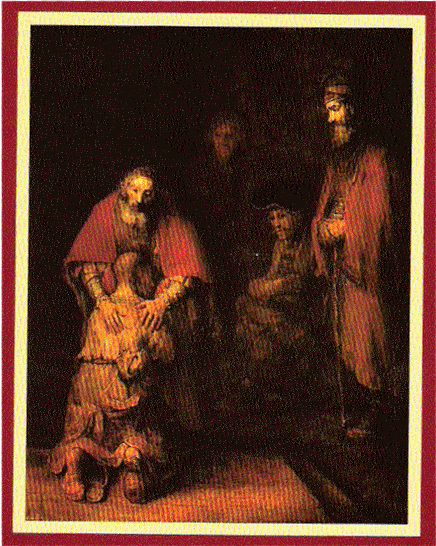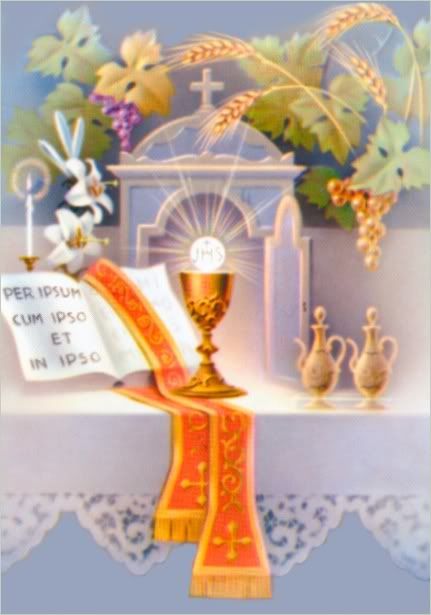Saturday, December 01, 2018
Saint Edmund Campion, Priest & Martyr

The Catholic Encylopedia on this heroic martyred priest.
Wikipedia
Here is the text of Campion's Brag, his defense of the Faith against the English protestant establishment.
To the Right Honourable, the Lords of Her Majesty's Privy Council:
Whereas I have come out of Germany and Bohemia, being sent by my superiors, and adventured myself into this noble realm, my dear country, for the glory of God and benefit of souls, I thought it like enough that, in this busy, watchful, and suspicious world, I should either sooner or later be intercepted and stopped of my course.
Wherefore, providing for all events, and uncertain what may become of me, when God shall haply deliver my body into durance, I supposed it needful to put this in writing in a readiness, desiring your good lordships to give it your reading, for to know my cause. This doing, I trust I shall ease you of some labour. For that which otherwise you must have sought for by practice of wit, I do now lay into your hands by plain confession. And to the intent that the whole matter may be conceived in order, and so the better both understood and remembered, I make thereof these nine points or articles, directly, truly and resolutely opening my full enterprise and purpose.
i. I confess that I am (albeit unworthy) a priest of the Catholic Church, and through the great mercy of God vowed now these eight years into the religion [religious order] of the Society of Jesus. Hereby I have taken upon me a special kind of warfare under the banner of obedience, and also resigned all my interest or possibility of wealth, honour, pleasure, and other worldly felicity.
ii. At the voice of our General, which is to me a warrant from heaven and oracle of Christ, I took my voyage from Prague to Rome (where our General Father is always resident) and from Rome to England, as I might and would have done joyously into any part of Christendom or Heatheness, had I been thereto assigned.
iii. My charge is, of free cost to preach the Gospel, to minister the Sacraments, to instruct the simple, to reform sinners, to confute errors—in brief, to cry alarm spiritual against foul vice and proud ignorance, wherewith many of my dear countrymen are abused.
iv. I never had mind, and am strictly forbidden by our Father that sent me, to deal in any respect with matter of state or policy of this realm, as things which appertain not to my vocation, and from which I gladly restrain and sequester my thoughts.
v. I do ask, to the glory of God, with all humility, and under your correction, three sorts of indifferent and quiet audiences: the first, before your Honours, wherein I will discourse of religion, so far as it toucheth the common weal and your nobilities: the second, whereof I make more account, before the Doctors and Masters and chosen men of both universities, wherein I undertake to avow the faith of our Catholic Church by proofs innumerable—Scriptures, councils, Fathers, history, natural and moral reasons: the third, before the lawyers, spiritual and temporal, wherein I will justify the said faith by the common wisdom of the laws standing yet in force and practice.
vi. I would be loath to speak anything that might sound of any insolent brag or challenge, especially being now as a dead man to this world and willing to put my head under every man's foot, and to kiss the ground they tread upon. Yet I have such courage in avouching the majesty of Jesus my King, and such affiance in his gracious favour, and such assurance in my quarrel, and my evidence so impregnable, and because I know perfectly that no one Protestant, nor all the Protestants living, nor any sect of our adversaries (howsoever they face men down in pulpits, and overrule us in their kingdom of grammarians and unlearned ears) can maintain their doctrine in disputation. I am to sue most humbly and instantly for combat with all and every of them, and the most principal that may be found: protesting that in this trial the better furnished they come, the better welcome they shall be.
vii. And because it hath pleased God to enrich the Queen my Sovereign Lady with notable gifts of nature, learning, and princely education, I do verily trust that if her Highness would vouchsafe her royal person and good attention to such a conference as, in the second part of my fifth article I have motioned, or to a few sermons, which in her or your hearing I am to utter such manifest and fair light by good method and plain dealing may be cast upon these controversies, that possibly her zeal of truth and love of her people shall incline her noble Grace to disfavour some proceedings hurtful to the realm, and procure towards us oppressed more equity.
viii. Moreover I doubt not but you, her Highness' Council, being of such wisdom and discreet in cases most important, when you shall have heard these questions of religion opened faithfully, which many times by our adversaries are huddled up and confounded, will see upon what substantial grounds our Catholic Faith is builded, how feeble that side is which by sway of the time prevaileth against us, and so at last for your own souls, and for many thousand souls that depend upon your government, will discountenance error when it is bewrayed [revealed], and hearken to those who would spend the best blood in their bodies for your salvation. Many innocent hands are lifted up to heaven for you daily by those English students, whose posterity shall never die, which beyond seas, gathering virtue and sufficient knowledge for the purpose, are determined never to give you over, but either to win you heaven, or to die upon your pikes. And touching our Society, be it known to you that we have made a league—all the Jesuits in the world, whose succession and multitude must overreach all the practice of England—cheerfully to carry the cross you shall lay upon us, and never to despair your recovery, while we have a man left to enjoy your Tyburn, or to be racked with your torments, or consumed with your prisons. The expense is reckoned, the enterprise is begun; it is of God; it cannot be withstood. So the faith was planted: So it must be restored.
ix. If these my offers be refused, and my endeavours can take no place, and I, having run thousands of miles to do you good, shall be rewarded with rigour. I have no more to say but to recommend your case and mine to Almighty God, the Searcher of Hearts, who send us his grace, and see us at accord before the day of payment, to the end we may at last be friends in heaven, when all injuries shall be forgotten.
Friday, November 30, 2018
Saint Andrew, Apostle & Martyr

From The Golden Legend
Today, the Church celebrates Saint Andrew, brother of Simon Peter, disciple of John the Baptist, and Apostle of the Lord.
Andrew was a fisherman from Capharnaum. He was with John the Baptist at the time of the baptism of the Lord, and followed Him from that time, later bringing Peter into the fold of the apostolic college. It was Andrew who reported the state of the food supply to the Lord before the feeding of the five thousand. But ortherwise, he appears to have faded into the apostolic group.
Andrew exercised his ministry in the region of the Black Sea, and was crucified on an "X" form crucifix at Patras in Achaia. He is the patron of fishermen and fishmongers, as well as patron of Scotland.
The St. Andrew's Novena (also called the Christmas Anticipation Novena) begins today, and runs through Christmas Eve.
“Hail and blessed
be the hour and the moment
when the Son of God was born
of the most pure Virgin Mary,
at midnight,
in a stable,
in Bethlehem,
in the piercing cold.
In that hour vouchsafe,
O my God,
to hear my prayer
and grant my desires,
through the merits
of Our Savior Jesus Christ,
and of His Blessed Mother.
Amen."
Sunday, November 25, 2018
Sad News For the Church
Bishop Robert Molino, of the Diocese of Madison, Wisconsin, has unexpectedly died at the age of 71.
http://wdtprs.com/blog/2018/11/r-i-p-most-reverend-robert-c-morlino-bishop-of-madison/
Traditionalist Catholics across the US have found a Good Shepard in Bishop Molino, and widely view him as the best US bishops after Cardinal Burke.
To make the blow worse, his successor will surely be appointed by Pope Francis, meaning a Wuerlite or Cupichite will succeed him endangering all the great work Bishop Molino accomplished.
Requiem aeternam dona ei Domine.
Et lux perpetua luceat ei.
Requiescat in pace.
Amen.
Stir-Up Sunday
This Sunday, the last of the liturgical year, gets its name from the Collect for today's Mass, which begins, "Stir up, O Lord...". It has nothing to do with cooking.
I will point you to Father Zuhlsdorf for an excellent explanation of the Last Sunday After Pentecost.
I would just add that the Gospel for today, with its discussion of the end of time, and the Last Trumpet, plus the repetition in the various prayers of the first line from the De Profundis (the 129/130th Psalm, one of the Penitential Psalms which is featured most prominently in the Office of the Dead and in the Requiem Mass), "Out of the depths, I cry unto Thee, O Lord...", reminds us that November is the month to pray with special vigor and earnestness for the dead. Next week we begin a new liturgical yeaar, and the season of Advent, switch to purple vestmests and altar cloths, and substitute the Alma Redemptor Mater, for the very familiar Salve Regina as the end of the day Marian hymn. But in the time we have before then, even with the distraction of Thanksgiving, we can still focus on praying for the Poor Souls in Purgatory.
However, since this is about the time you want to make up the mincemeat, plum pudding, and Twelfth Cake so that it will be properly aged and mellowed and inebriated by the Christmas holy days, Stir Up Sunday has taken on the identity as the day you stir up and cook these delicacies.
Let us start with the Mincemeat:

Mincemeat pie is, of course, traditionally associated with Christmas.
But in New England, where the celebration of Christmas was relatively restrained for the first 150 or so years of our history, it was adopted as a Thanksgiving food. Thanksgiving tables in Massachusetts from 1740-1870 often boasted a mince pie. Just goes to show you that you can't keep a good mince pie down (or a bad one, but that is a different matter).
Today, when you go out picking apples in September or early October, one of the things you can do with the bushels that come home is to make mincemeat, and thus you can begin making ready for both Thanksgiving and Christmas.
You can either freeze the mincemeat in ziploc bags, or bake into pies, and freeze the pies until needed. I prefer the former method. In either case, it is a good thing to beat the holiday rush by getting your mincemeat ready now. If you double-bag the mincemeat, it should keep in the fridge for many months. At Thanksgiving and Christmas, nothing says "home" like a warm mincemeat pie.
This pie was actually outlawed in New England during the earliest period of Massachusetts history, as it is a symbol of Christmas, the celebration of which was also against the law. The pie has been variously known as Neat's Pie, Shrid Pie, Christmas Pie, Mutton Pie, and of course, Mince Pie (which was more or less common by the end of the 18th century). As a staple of English and Irish cuisine, it dates back to medieval times at least.
Little Jack Horner's Christmas Pie, was, of course, mincemeat. The plumb he pulled out with his thumb was in fact the deed to a plundered parcel of Church property, the deed to which, along with many others, was inserted into a huge Christmas Pie to be delivered, by Horner, to Henry VIII. Somehow, the property found its way into the possession of Horner, rather than Henry.
This would be a good time to try to correct a modern misconception. Raisins were known by various regional words in England and Ireland. In parts of England, they are called "figs." In other parts, they are called "plumbs" or "plums." In no case were either what we know as figs or plums ever included in traditional mincemeat, or plum pudding, or fruitcake.
All those recipes you see for plum pudding that call for plums?
Rip them out of your cookbook. Burn the pages, lest others fall into this heresy.
The same with "Figgy Pudding" recipes with figs. All you want are raisins and currants. Got it? Figgy Pudding does not have figs. Plum Pudding does not have plums. They are, in fact, the same thing, and both have raisins.
I am a firm believer that the better the quality of the ingredients you use, the better the finished product will taste. That is why I use sirloin tips rather than suet or stew beef, and fresh orchard cider from Brooksby Farm in peabody, and apples picked that weekend by hand, and by me.
This recipe will make many pies.
If there is a lot of liquid, drain it off and freeze it separately, as it can be served by itself either hot or cold as plum porridge. I suspect that the extra liquid from making mince pie was how that soup got started. Eat the plum porridge in small amounts, as even I would say it is very, very rich.
10 cups chopped apples, preferably freshly picked
4 cups diced sirloin tip meat fried or broiled (I pan fry)
2 cups of beef stock (your own, or canned)
2 cups of fresh sweet apple cider
8 cups of sugar
1 cup of molasses
3 tablespoons of cinnamon
2 teaspoons of ground cloves
4 lemons, rind and juice
3 tablespoons of salt
3 pounds of seedless raisins
1 pound of currants
1/2 pound of citron
1/4 pound candied or fresh orange rind
1/4 pound candied or fresh lemon rind
1 cup brandy (don't use "cooking brandy")
1 cup Captain Morgan's Spiced Rum
at pie-making time
orange flower water, to taste
French brandy, to taste
Captain Morgan's, to taste
freshly ground nutmeg
cinnamon-sugar to taste
(No, your teeth will not fall out, at least not right away.)
Chop the apples and beef finely. Pan fry the sirloin tips until medium rare, then dice or shred them into tiny bits. Place the apples and beef into a very large pot with all the remaining measured ingredients.
Simmer slowly for up to three hours, stirring every few minutes.
The aroma is incredible, and will make the house smell like the holidays in no time.
After a few hours, take the mincemeat off the heat, and allow it to cool.
Once the mincemeat has cooled, drain the excess liquid for plum porridge, and freeze it in a separate container (that won't leak in your freezer).
Put the mincemeat into gallon Ziplocs, and freeze.
There should be enough mincemeat for 6-8 9-inch mince pies (or lots of small mincemeat pies).
But the mince pie is so rich, you might want to serve it in tart or individual serving-size pie pans.
When it's time for making the pies, thaw the mincemeat in the refrigerator for a day or two.
Make two short crusts for each pie. Line the pie pan with crust. Add the mincemeat. Pour on some orange flower water, Captain Morgan's, and brandy, dot the pie with some small pats of butter, and a grating of fresh nutmeg to taste.
I use fairly liberal doses of all in my mince pies.
Put on the top layer of crust, and seal the edges, leaving ventilation slits in the top crust.
Bake for 10 minutes at 450 degrees (you may want a drip tray under the pie in the oven), and then for 30 minutes at 350 degrees, but watch the crust carefully. Use of one of those shields that protect the edges is recommended.
When the pie is fresh out of the oven, sprinkle the top with a generous portion of cinnamon-sugar.
Once baked, the pies keep in the fridge for a week.
They taste terrific warm or cold. Vanilla ice cream is great on top. Eggnog Ice Cream would not be too much.
You expect to put on some weight during the holidays. Live a little!
Fruit Cake/Christmas Cake/Twelfth Cake

The recipe that follows is a modified version of Martha Washington's recipe for what she called "Great Cake," or her cake for great occasions. Her recipe calls for taking forty eggs, separating them, and beating the whites to a froth with a bundle of sticks. Well, eggs were smaller then. And the bundle of sticks has long given way to the electric mixer. Thank Heavens!
If you want to try it, read the recipe through first, so that you will be sure to have everything you need.
1 pound raisins
11 oz. currants
1 cup candied orange peel
1 cup candied lemon peel
1 cup citron
1 cup of candied red cherries
1 cup of candied green cherries
good brandy (warning: this is not a recipe for those recovering from a drinking problem)
Put all the fruit into a large bowl, and cover it with the brandy. Cover the bowl, and let the fruit soak in the brandy for a couple of days.
41/2 cups of all purpose flour
1 teaspoon mace
1 teaspoon nutmeg
1 tablespoon cinnamon
1 teaspoon ginger
1 teaspoon ground cloves
4 sticks of butter softened
2 1/2 cups sugar
10 eggs, separated
2 teaspoons lemon juice
1/3 cup of cream sherry
the remainder of the bottle of cream sherry (I use Savory & James: inexpensive but tastes nice)
Once the fruit has soaked for at least 36 hours (sometimes, I let it soak for 5-6 days on the counter), sift together the flour and spices, and set it aside.
Work the butter until it is creamy, then add one cup of sugar a little at a time. Beat it until it is smooth.
Beat the egg yolks until they are thick and light. Then add 1 cup of sugar to the yolks. Add the lemon juice to the yolks after the sugar is added. Combine the yolk mixture with the butter-sugar mixture. Add the rest of the sugar.
Add the flour/spices and 1/3 cup sherry both little-by-little and alternating with each other.
Once all the flour/spices and the 1/3 cup of sherry have been added to the egg yolk/butter/sugar mixture, drain the fruit (I've never tried to drink the brandy, but I don't suppose it would do much harm), and add it also.
Now beat the egg whites until they are stiff. Fold the egg whites into the batter.
Grease and flour a 10-inch tube pan (don't forget to grease the tube itself). Pour the batter into the pan. Put a pan of hot water on the bottom rack of the oven, and pre-heat to 350 degrees. Bake at 350 degrees for 20 minutes. Then reduce heat to 325 degrees and bake for another hour and forty minutes. The cake is done when a knife inserted in it comes out clean.
Turn the cake out gently, and let it cool on a rack. Soak lots of cheese cloth in the rest of the sherry. Wrap the cake in the sherry-soaked cheese cloth, then put it in an airtight Rubbermaid (or other airtight plastic cake container) for three weeks.
Each week, check the cheese cloth to see if it is still moist. If it has dried out, soak it in more cream sherry, and re-apply. The longer the cake cures, the better. Just this past summer, I found in the pantry a Christmas cake made two years ago, and happily sliced it up. It was delicious. All the sugar, spice, and booze in the mix makes it almost as everlasting as the Twinkie, except it improves with age, unlike the Hostess Twinkie.
Martha Washington's Plum Pudding

2 1/2 lb raisins
3/4 c brandy
2 ts cinnamon
1/2 ts cloves
1 ts allspice
2 ts mace
1 1/2 ts nutmeg
1 lb beef suet, minced
1/2 c grated orange peel
1/4 c grated lemon peel
1 lb citron
2 c flour
7 eggs, beaten
2 c sugar
Instructions
According to her time-honored recipe, you take three days to prepare this great concoction.
First, the raisins are cooked until soft. Leave the fruit in
its cooking water and add brandy and spices. let mixture steep for 2
days in cool place.
When the day comes of baking, drain off liquid. Add beef suet, grated
orange and lemon peel and citron, combining further with flour, eggs
and sugar. Press into a butter bread-loaf pan, cover tightly, and
steam for 6 hours. You will have the famous pudding.
Ok.
Mincemeat. Check.
Fruitcake. Check.
Plum Pudding. Check.
Eggnog? It's too early to worry about the eggnog. Wait for Christmas week for that.
I will point you to Father Zuhlsdorf for an excellent explanation of the Last Sunday After Pentecost.
I would just add that the Gospel for today, with its discussion of the end of time, and the Last Trumpet, plus the repetition in the various prayers of the first line from the De Profundis (the 129/130th Psalm, one of the Penitential Psalms which is featured most prominently in the Office of the Dead and in the Requiem Mass), "Out of the depths, I cry unto Thee, O Lord...", reminds us that November is the month to pray with special vigor and earnestness for the dead. Next week we begin a new liturgical yeaar, and the season of Advent, switch to purple vestmests and altar cloths, and substitute the Alma Redemptor Mater, for the very familiar Salve Regina as the end of the day Marian hymn. But in the time we have before then, even with the distraction of Thanksgiving, we can still focus on praying for the Poor Souls in Purgatory.
However, since this is about the time you want to make up the mincemeat, plum pudding, and Twelfth Cake so that it will be properly aged and mellowed and inebriated by the Christmas holy days, Stir Up Sunday has taken on the identity as the day you stir up and cook these delicacies.
Let us start with the Mincemeat:

Mincemeat pie is, of course, traditionally associated with Christmas.
But in New England, where the celebration of Christmas was relatively restrained for the first 150 or so years of our history, it was adopted as a Thanksgiving food. Thanksgiving tables in Massachusetts from 1740-1870 often boasted a mince pie. Just goes to show you that you can't keep a good mince pie down (or a bad one, but that is a different matter).
Today, when you go out picking apples in September or early October, one of the things you can do with the bushels that come home is to make mincemeat, and thus you can begin making ready for both Thanksgiving and Christmas.
You can either freeze the mincemeat in ziploc bags, or bake into pies, and freeze the pies until needed. I prefer the former method. In either case, it is a good thing to beat the holiday rush by getting your mincemeat ready now. If you double-bag the mincemeat, it should keep in the fridge for many months. At Thanksgiving and Christmas, nothing says "home" like a warm mincemeat pie.
This pie was actually outlawed in New England during the earliest period of Massachusetts history, as it is a symbol of Christmas, the celebration of which was also against the law. The pie has been variously known as Neat's Pie, Shrid Pie, Christmas Pie, Mutton Pie, and of course, Mince Pie (which was more or less common by the end of the 18th century). As a staple of English and Irish cuisine, it dates back to medieval times at least.
Little Jack Horner's Christmas Pie, was, of course, mincemeat. The plumb he pulled out with his thumb was in fact the deed to a plundered parcel of Church property, the deed to which, along with many others, was inserted into a huge Christmas Pie to be delivered, by Horner, to Henry VIII. Somehow, the property found its way into the possession of Horner, rather than Henry.
This would be a good time to try to correct a modern misconception. Raisins were known by various regional words in England and Ireland. In parts of England, they are called "figs." In other parts, they are called "plumbs" or "plums." In no case were either what we know as figs or plums ever included in traditional mincemeat, or plum pudding, or fruitcake.
All those recipes you see for plum pudding that call for plums?
Rip them out of your cookbook. Burn the pages, lest others fall into this heresy.
The same with "Figgy Pudding" recipes with figs. All you want are raisins and currants. Got it? Figgy Pudding does not have figs. Plum Pudding does not have plums. They are, in fact, the same thing, and both have raisins.
I am a firm believer that the better the quality of the ingredients you use, the better the finished product will taste. That is why I use sirloin tips rather than suet or stew beef, and fresh orchard cider from Brooksby Farm in peabody, and apples picked that weekend by hand, and by me.
This recipe will make many pies.
If there is a lot of liquid, drain it off and freeze it separately, as it can be served by itself either hot or cold as plum porridge. I suspect that the extra liquid from making mince pie was how that soup got started. Eat the plum porridge in small amounts, as even I would say it is very, very rich.
10 cups chopped apples, preferably freshly picked
4 cups diced sirloin tip meat fried or broiled (I pan fry)
2 cups of beef stock (your own, or canned)
2 cups of fresh sweet apple cider
8 cups of sugar
1 cup of molasses
3 tablespoons of cinnamon
2 teaspoons of ground cloves
4 lemons, rind and juice
3 tablespoons of salt
3 pounds of seedless raisins
1 pound of currants
1/2 pound of citron
1/4 pound candied or fresh orange rind
1/4 pound candied or fresh lemon rind
1 cup brandy (don't use "cooking brandy")
1 cup Captain Morgan's Spiced Rum
at pie-making time
orange flower water, to taste
French brandy, to taste
Captain Morgan's, to taste
freshly ground nutmeg
cinnamon-sugar to taste
(No, your teeth will not fall out, at least not right away.)
Chop the apples and beef finely. Pan fry the sirloin tips until medium rare, then dice or shred them into tiny bits. Place the apples and beef into a very large pot with all the remaining measured ingredients.
Simmer slowly for up to three hours, stirring every few minutes.
The aroma is incredible, and will make the house smell like the holidays in no time.
After a few hours, take the mincemeat off the heat, and allow it to cool.
Once the mincemeat has cooled, drain the excess liquid for plum porridge, and freeze it in a separate container (that won't leak in your freezer).
Put the mincemeat into gallon Ziplocs, and freeze.
There should be enough mincemeat for 6-8 9-inch mince pies (or lots of small mincemeat pies).
But the mince pie is so rich, you might want to serve it in tart or individual serving-size pie pans.
When it's time for making the pies, thaw the mincemeat in the refrigerator for a day or two.
Make two short crusts for each pie. Line the pie pan with crust. Add the mincemeat. Pour on some orange flower water, Captain Morgan's, and brandy, dot the pie with some small pats of butter, and a grating of fresh nutmeg to taste.
I use fairly liberal doses of all in my mince pies.
Put on the top layer of crust, and seal the edges, leaving ventilation slits in the top crust.
Bake for 10 minutes at 450 degrees (you may want a drip tray under the pie in the oven), and then for 30 minutes at 350 degrees, but watch the crust carefully. Use of one of those shields that protect the edges is recommended.
When the pie is fresh out of the oven, sprinkle the top with a generous portion of cinnamon-sugar.
Once baked, the pies keep in the fridge for a week.
They taste terrific warm or cold. Vanilla ice cream is great on top. Eggnog Ice Cream would not be too much.
You expect to put on some weight during the holidays. Live a little!
Fruit Cake/Christmas Cake/Twelfth Cake

The recipe that follows is a modified version of Martha Washington's recipe for what she called "Great Cake," or her cake for great occasions. Her recipe calls for taking forty eggs, separating them, and beating the whites to a froth with a bundle of sticks. Well, eggs were smaller then. And the bundle of sticks has long given way to the electric mixer. Thank Heavens!
If you want to try it, read the recipe through first, so that you will be sure to have everything you need.
1 pound raisins
11 oz. currants
1 cup candied orange peel
1 cup candied lemon peel
1 cup citron
1 cup of candied red cherries
1 cup of candied green cherries
good brandy (warning: this is not a recipe for those recovering from a drinking problem)
Put all the fruit into a large bowl, and cover it with the brandy. Cover the bowl, and let the fruit soak in the brandy for a couple of days.
41/2 cups of all purpose flour
1 teaspoon mace
1 teaspoon nutmeg
1 tablespoon cinnamon
1 teaspoon ginger
1 teaspoon ground cloves
4 sticks of butter softened
2 1/2 cups sugar
10 eggs, separated
2 teaspoons lemon juice
1/3 cup of cream sherry
the remainder of the bottle of cream sherry (I use Savory & James: inexpensive but tastes nice)
Once the fruit has soaked for at least 36 hours (sometimes, I let it soak for 5-6 days on the counter), sift together the flour and spices, and set it aside.
Work the butter until it is creamy, then add one cup of sugar a little at a time. Beat it until it is smooth.
Beat the egg yolks until they are thick and light. Then add 1 cup of sugar to the yolks. Add the lemon juice to the yolks after the sugar is added. Combine the yolk mixture with the butter-sugar mixture. Add the rest of the sugar.
Add the flour/spices and 1/3 cup sherry both little-by-little and alternating with each other.
Once all the flour/spices and the 1/3 cup of sherry have been added to the egg yolk/butter/sugar mixture, drain the fruit (I've never tried to drink the brandy, but I don't suppose it would do much harm), and add it also.
Now beat the egg whites until they are stiff. Fold the egg whites into the batter.
Grease and flour a 10-inch tube pan (don't forget to grease the tube itself). Pour the batter into the pan. Put a pan of hot water on the bottom rack of the oven, and pre-heat to 350 degrees. Bake at 350 degrees for 20 minutes. Then reduce heat to 325 degrees and bake for another hour and forty minutes. The cake is done when a knife inserted in it comes out clean.
Turn the cake out gently, and let it cool on a rack. Soak lots of cheese cloth in the rest of the sherry. Wrap the cake in the sherry-soaked cheese cloth, then put it in an airtight Rubbermaid (or other airtight plastic cake container) for three weeks.
Each week, check the cheese cloth to see if it is still moist. If it has dried out, soak it in more cream sherry, and re-apply. The longer the cake cures, the better. Just this past summer, I found in the pantry a Christmas cake made two years ago, and happily sliced it up. It was delicious. All the sugar, spice, and booze in the mix makes it almost as everlasting as the Twinkie, except it improves with age, unlike the Hostess Twinkie.
Martha Washington's Plum Pudding

2 1/2 lb raisins
3/4 c brandy
2 ts cinnamon
1/2 ts cloves
1 ts allspice
2 ts mace
1 1/2 ts nutmeg
1 lb beef suet, minced
1/2 c grated orange peel
1/4 c grated lemon peel
1 lb citron
2 c flour
7 eggs, beaten
2 c sugar
Instructions
According to her time-honored recipe, you take three days to prepare this great concoction.
First, the raisins are cooked until soft. Leave the fruit in
its cooking water and add brandy and spices. let mixture steep for 2
days in cool place.
When the day comes of baking, drain off liquid. Add beef suet, grated
orange and lemon peel and citron, combining further with flour, eggs
and sugar. Press into a butter bread-loaf pan, cover tightly, and
steam for 6 hours. You will have the famous pudding.
Ok.
Mincemeat. Check.
Fruitcake. Check.
Plum Pudding. Check.
Eggnog? It's too early to worry about the eggnog. Wait for Christmas week for that.





